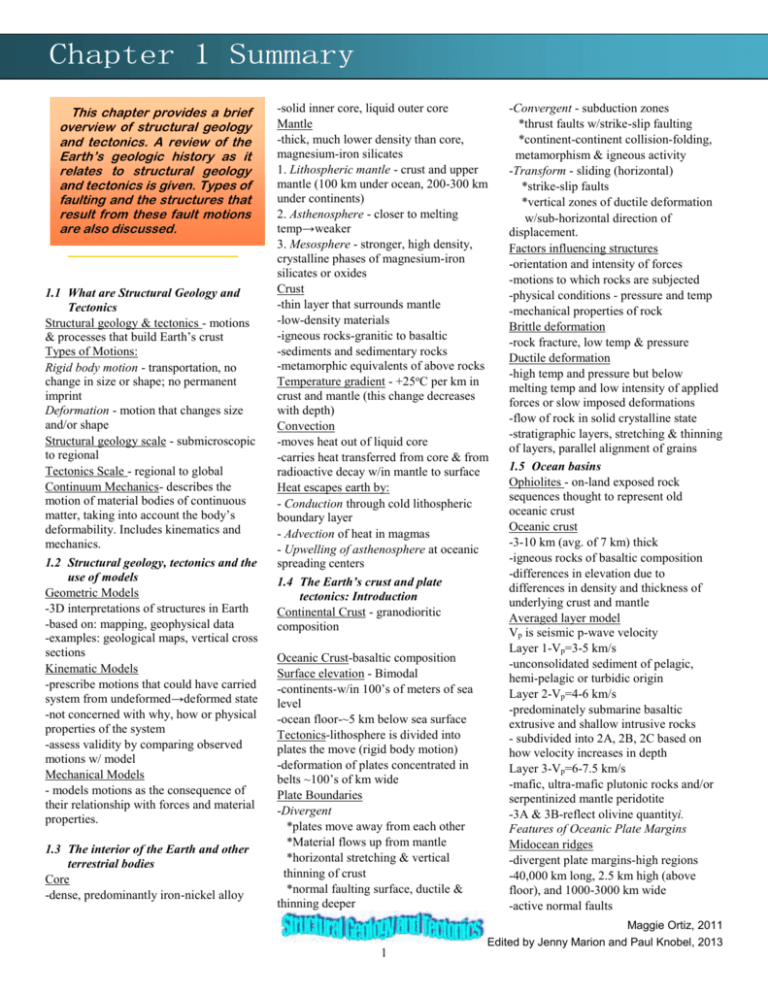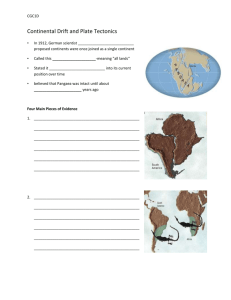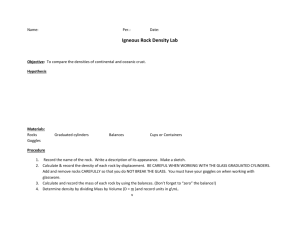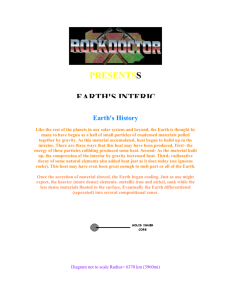Introduction to Structural Geology
advertisement

This chapter provides a brief overview of structural geology and tectonics. A review of the Earth’s geologic history as it relates to structural geology and tectonics is given. Types of faulting and the structures that result from these fault motions are also discussed. 1.1 What are Structural Geology and Tectonics Structural geology & tectonics - motions & processes that build Earth’s crust Types of Motions: Rigid body motion - transportation, no change in size or shape; no permanent imprint Deformation - motion that changes size and/or shape Structural geology scale - submicroscopic to regional Tectonics Scale - regional to global Continuum Mechanics- describes the motion of material bodies of continuous matter, taking into account the body’s deformability. Includes kinematics and mechanics. 1.2 Structural geology, tectonics and the use of models Geometric Models -3D interpretations of structures in Earth -based on: mapping, geophysical data -examples: geological maps, vertical cross sections Kinematic Models -prescribe motions that could have carried system from undeformed→deformed state -not concerned with why, how or physical properties of the system -assess validity by comparing observed motions w/ model Mechanical Models - models motions as the consequence of their relationship with forces and material properties. 1.3 The interior of the Earth and other terrestrial bodies Core -dense, predominantly iron-nickel alloy -solid inner core, liquid outer core Mantle -thick, much lower density than core, magnesium-iron silicates 1. Lithospheric mantle - crust and upper mantle (100 km under ocean, 200-300 km under continents) 2. Asthenosphere - closer to melting temp→weaker 3. Mesosphere - stronger, high density, crystalline phases of magnesium-iron silicates or oxides Crust -thin layer that surrounds mantle -low-density materials -igneous rocks-granitic to basaltic -sediments and sedimentary rocks -metamorphic equivalents of above rocks Temperature gradient - +25oC per km in crust and mantle (this change decreases with depth) Convection -moves heat out of liquid core -carries heat transferred from core & from radioactive decay w/in mantle to surface Heat escapes earth by: - Conduction through cold lithospheric boundary layer - Advection of heat in magmas - Upwelling of asthenosphere at oceanic spreading centers 1.4 The Earth’s crust and plate tectonics: Introduction Continental Crust - granodioritic composition Oceanic Crust-basaltic composition Surface elevation - Bimodal -continents-w/in 100’s of meters of sea level -ocean floor-~5 km below sea surface Tectonics-lithosphere is divided into plates the move (rigid body motion) -deformation of plates concentrated in belts ~100’s of km wide Plate Boundaries -Divergent *plates move away from each other *Material flows up from mantle *horizontal stretching & vertical thinning of crust *normal faulting surface, ductile & thinning deeper 1 -Convergent - subduction zones *thrust faults w/strike-slip faulting *continent-continent collision-folding, metamorphism & igneous activity -Transform - sliding (horizontal) *strike-slip faults *vertical zones of ductile deformation w/sub-horizontal direction of displacement. Factors influencing structures -orientation and intensity of forces -motions to which rocks are subjected -physical conditions - pressure and temp -mechanical properties of rock Brittle deformation -rock fracture, low temp & pressure Ductile deformation -high temp and pressure but below melting temp and low intensity of applied forces or slow imposed deformations -flow of rock in solid crystalline state -stratigraphic layers, stretching & thinning of layers, parallel alignment of grains 1.5 Ocean basins Ophiolites - on-land exposed rock sequences thought to represent old oceanic crust Oceanic crust -3-10 km (avg. of 7 km) thick -igneous rocks of basaltic composition -differences in elevation due to differences in density and thickness of underlying crust and mantle Averaged layer model Vp is seismic p-wave velocity Layer 1-Vp=3-5 km/s -unconsolidated sediment of pelagic, hemi-pelagic or turbidic origin Layer 2-Vp=4-6 km/s -predominately submarine basaltic extrusive and shallow intrusive rocks - subdivided into 2A, 2B, 2C based on how velocity increases in depth Layer 3-Vp=6-7.5 km/s -mafic, ultra-mafic plutonic rocks and/or serpentinized mantle peridotite -3A & 3B-reflect olivine quantityi. Features of Oceanic Plate Margins Midocean ridges -divergent plate margins-high regions -40,000 km long, 2.5 km high (above floor), and 1000-3000 km wide -active normal faults Maggie Ortiz, 2011 Edited by Jenny Marion and Paul Knobel, 2013 Transform fault boundaries -seismically active parts of fracture zones -sharp ridge and trough topography -steeply dipping faults -deformed oceanic rocks -up to 10,000 km long, up to 100 km wide -crust tends to be less thick here Convergent -Chains of volcanic islands accompanied by parallel trenches (island-arc-deep sea trench pairs) -extend 1000’s of km -volcanoes 70-80 km apart-rise above ridges-few 100 km wide -trenches-up to 12km deep, ~100km wide *landward side-active thrust faults -crust- ~25 km thick ii. Features of oceanic plate interiors Abyssal plains -vast areas of flat ocean floor -deepest regions of ocean -5 km below sea level Oceanic plateaus -broad elevated regions -variety of origins -100-1000’s 0f km2 area -1-4 km above normal ocean floor Aseismic ridges -linear ridges characterized by high elevation, thick crust, and lack of associated seismic activity -most cases-linear constructional ridges formed by chains of basaltic volcanoes 1.6 The structure of continental crust Continental crust -older, thicker, less dense, lower velocity -~35 km thick (average) -velocity tends to increase with depth -velocity inversions Upper crust-metamorphosed rocks intruded in places by granitic rocks Middle crust-migmatite Lower crust-highly folded rocks -moho discontinuity is less sharp 1.7 Precambrian shields -Precambrian shield-large areas where Precambrian rock >60 Ma are exposed -Archean rocks- >2500 Ma -Proterozoic rocks- 2500 Ma to 540 Ma -Archean regions-greater evidence of crustal instability i. Archean terranes Archean Terranes -divisible on basis of metamorphic grades -high grade gneissic regions *amphibolite or granulitic facies of metamorphism *form bulk of archean regions *quartz-feldspathic gneisses derived by metamorphism of felsic igneous rocks *complexly mixed with greenstone belts over 10-100’s of km - greenstone belts - rocks at greenschist or lower grades of metamorphism *Greenstone - mafic to silicic volcanic rocks and shallow intrusive bodies Sutures-regions of deformed oceanic material thought to be remnants of disappeared oceans Structural features of Archean Terranes -highly deformed and display more than 1 generation of folds -contacts between gneissic and greenstone are complex -sedimentary rock types fall into one of two categories: *immature volcanogenic sediments *quartzite-carbonate-iron-assemblages -Similar sedimentary and tectonic conditions occurred globally during Archean times During Archean: -higher temps in earth -thermal gradient 2-3x higher than present -plate tectonics likely operated -oceanic crust prob. thicker -continents smaller and less numerous ii. Proterozoic terranes Terranes include both highly deformed mobile areas and slightly deformed stable regions -Cratons - tectonically stable regions of crust (became abundant in Proterozoic) Deformed belts -multiply deformed regions rich in volcanic rocks -thick sedimentary sequences deposited in linear troughs - include Proterozoic dike swarms Aulacogens-series of smaller linear sediment-filled grabens 1.8 Phanerozoic regions i. Interior lowlands and cratonic platforms -most platform sediments are marine ii. Orogenic belts -thick sequences of shallow-water sandstones, limestones and shales deposited on continental crust -crude bilateral symmetry -form at convergent margins iii. Continental rifts -abundant normal faulting, shallow EQ activity, mountainous topography iv. Modern continental margins Passive, rifted, or Atlantic-style margins (horizontally lengthened and vertically thinned continental crust) -initiate at divergent plate boundaries Convergent or Andean-style margins -where consuming plate boundaries are located along a continental margin -abrupt topographic change from a deep sea trench offshore to a high belt of mountains w/in 100-200 km off the coast -narrow or absent continental shelf -mountains have chain of active stratovolcanoes Transform or California-style margins -sharp topographic differences between oceans and continents - active strike-slip faulting, poorly developed shelf, irregular ridge & basin topography and many deep sedimentary basins Back-arc or Japan style margins -composite margins - passive margin separated by narrow oceanic region from an active island arc Maggie Ortiz, 2011 Edited by Jenny Marion and Paul Knobel, 2013 2








